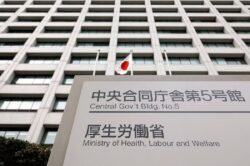
Prime Minister Yoshihide Suga speaks at the Prime Minister’s Office on Wednesday.
13:13 JST, December 17, 2020
The number of people newly infected with the novel coronavirus rose to 18,027 in the week that ended Tuesday, a 25% increase from the week immediately before the government called for intensive infection control measures, the Yomiuri Shimbun has learned.
Prime Minister Yoshihide Suga said Wednesday: “[The number of infections] has remained high, and we are taking this situation seriously. We will do our utmost to protect the lives and livelihoods of the people.”
Based on materials released by local governments, The Yomiuri Shimbun compared the number of infections (excluding those confirmed at airport quarantine) from Nov. 18-24 — the week before Yasutoshi Nishimura, the minister in charge of economic revitalization and measures against the novel coronavirus, said on Nov. 25 that “the three weeks from now are the key to success” — with the number from Dec. 9 to 15, the last week of the three-week period.
The average number of new cases per day nationwide rose by 25%, from 2,059 to 2,575. Tokyo and Aichi prefecture, which are major cities with many infections, saw a 20% increase.
In Hiroshima and Kochi prefectures, where the numbers had been in the single digits, the number of cases increased to 10 times the previous level in Hiroshima Prefecture and to 35 times the earlier level in Kochi Prefecture, highlighting the spread of the virus to regional areas.
In Hokkaido, where infection control measures have been strengthened since early November, ahead of the rest of Japan, the number of cases began to decline.
The flow of people in various areas during the crucial three weeks did not decrease significantly. Using data from IT company Agoop Corp., which is affiliated with SoftBank Corp., The Yomiuri Shimbun compared the number of people in certain areas on weekends and holidays during the crucial three weeks with that from the three weeks before that.
The number of people dropped by more than 10% in some areas in Hokkaido and Osaka Prefecture. However, the decrease was less than 5% in areas including the Kabuki-cho district in Shinjuku Ward, Tokyo, the Center-gai shopping area in Tokyo’s Shibuya Ward, Sakae Station in Nagoya and Hakata Station in Fukuoka.
Suga said: “Experts have long pointed out that the risk of infection is high in situations where people eat and drink. A drop in temperature may also have an impact.”
■ ‘Dining out leads to clusters’
An advisory body to the Health, Labor and Welfare Ministry, which is examining measures against the novel coronavirus, said Wednesday that “cases of infection tend to be numerous or increase in areas with large populations and then spread to regional areas,” with nine prefectures, including Tokyo and Osaka, accounting for about 75% of all cases nationwide.
The recent outbreak of infection clusters at year-end parties and other dining occasions in regional areas was particularly notable, the advisory body said.
"Society" POPULAR ARTICLE
-

M4.9 Earthquake Hits Tokyo, Neighboring Prefectures
-

M7.5 Earthquake Hits Northern Japan; Tsunami Waves Observed in Hokkaido, Aomori and Iwate Prefectures
-

Tsukiji Market Urges Tourists to Avoid Visiting in Year-End
-

Israeli Tourists Refused Accommodation at Hotel in Japan’s Nagano Pref., Prompting Protest by Israeli Embassy and Probe by Prefecture
-

M5.7 Earthquake Hits Japan’s Kumamoto Pref., Measuring Upper 5 Intensity, No Tsunami Expected
JN ACCESS RANKING
-

Keidanren Chairman Yoshinobu Tsutsui Visits Kashiwazaki-Kariwa Nuclear Power Plant; Inspects New Emergency Safety System
-

Imports of Rare Earths from China Facing Delays, May Be Caused by Deterioration of Japan-China Relations
-

University of Tokyo Professor Discusses Japanese Economic Security in Interview Ahead of Forum
-

Japan Pulls out of Vietnam Nuclear Project, Complicating Hanoi’s Power Plans
-

Govt Aims to Expand NISA Program Lineup, Abolish Age Restriction

























